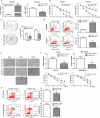Epigenetic silencing of miR-375 induces trastuzumab resistance in HER2-positive breast cancer by targeting IGF1R
- PMID: 24571711
- PMCID: PMC3974046
- DOI: 10.1186/1471-2407-14-134
Epigenetic silencing of miR-375 induces trastuzumab resistance in HER2-positive breast cancer by targeting IGF1R
Abstract
Background: Resistance to humanized monoclonal erbB2/HER2 antibody, trastuzumab (Herceptin), has become a pivotal obstacle for targeted therapy of HER2-positive breast cancers. The activation of alternative growth factor receptors, in particular, the insulin-like growth factor 1 receptor (IGF1R), represents a common feature of trastuzumab-refractory cells; however, the underlying mechanism remains elusive.
Methods: Trastuzumab-resistant breast cancer SKBr-3 cells were generated by long-term in vitro culture of SKBr-3 cells in the presence of trastuzumab. Among the differentially expressed microRNAs (miRNAs) screened by microarray analysis, candidate miRNA(s) predicted to target IGF1R was studied for its role in conferring trastuzumab resistance. The mechanism underlying decreased expression of IGF1R-targeted miRNA in refractory cells was also addressed.
Results: miR-375, which was downregulated and predicted to target IGF1R in trastuzumab-resistant HER2-positive breast cancer cells, could indeed inhibit the cellular luciferase activity in a reporter construct containing the 3'-UTR of IGF1R. Overexpression of miR-375 restored the sensitivity of cells to trastuzumab, while inhibition of miR-375 conferred trastuzumab resistance on HER2-positive breast cancer cells. Blockade of DNA methylation and histone deacetylation restored the expression of miR-375 in trastuzumab-resistant cells. A reverse correlation between the levels of miR-375 and IGF1R was validated in clinical breast cancers.
Conclusions: Epigenetic silencing of miR-375 causes the upregulation of IGF1R, which at least partially underlies trastuzumab resistance of breast cancer cells. Our study has implications for miR-375 as a potential target in combination with trastuzumab for treating HER2-positive breast cancers.
Figures





Similar articles
-
MiR-98-5p/IGF2 Axis Influence Herceptin Sensitivity through IGF1R/HER2 Heterodimer Formation and AKT/mTOR Signal Pathway in HER2 Positive Breast Cancer.Asian Pac J Cancer Prev. 2021 Nov 1;22(11):3693-3703. doi: 10.31557/APJCP.2021.22.11.3693. Asian Pac J Cancer Prev. 2021. PMID: 34837929 Free PMC article.
-
Up-regulation of miR-21 mediates resistance to trastuzumab therapy for breast cancer.J Biol Chem. 2011 May 27;286(21):19127-37. doi: 10.1074/jbc.M110.216887. Epub 2011 Apr 6. J Biol Chem. 2011. PMID: 21471222 Free PMC article.
-
Increased signalling of EGFR and IGF1R, and deregulation of PTEN/PI3K/Akt pathway are related with trastuzumab resistance in HER2 breast carcinomas.Br J Cancer. 2012 Apr 10;106(8):1367-73. doi: 10.1038/bjc.2012.85. Epub 2012 Mar 27. Br J Cancer. 2012. PMID: 22454081 Free PMC article.
-
Mechanisms of disease: understanding resistance to HER2-targeted therapy in human breast cancer.Nat Clin Pract Oncol. 2006 May;3(5):269-80. doi: 10.1038/ncponc0509. Nat Clin Pract Oncol. 2006. PMID: 16683005 Review.
-
Evolving strategies for overcoming resistance to HER2-directed therapy: targeting the PI3K/Akt/mTOR pathway.Clin Breast Cancer. 2010 Nov;10 Suppl 3:S72-8. doi: 10.3816/CBC.2010.s.015. Clin Breast Cancer. 2010. PMID: 21115425 Review.
Cited by
-
New Concepts in Cancer Biomarkers: Circulating miRNAs in Liquid Biopsies.Int J Mol Sci. 2016 Apr 27;17(5):627. doi: 10.3390/ijms17050627. Int J Mol Sci. 2016. PMID: 27128908 Free PMC article. Review.
-
miRNAs as biomarkers of therapeutic response to HER2-targeted treatment in breast cancer: A systematic review.Biochem Biophys Rep. 2023 Nov 28;37:101588. doi: 10.1016/j.bbrep.2023.101588. eCollection 2024 Mar. Biochem Biophys Rep. 2023. PMID: 38088952 Free PMC article. Review.
-
Decoding Insulin-Like Growth Factor Signaling Pathway From a Non-coding RNAs Perspective: A Step Towards Precision Oncology in Breast Cancer.J Mammary Gland Biol Neoplasia. 2022 Mar;27(1):79-99. doi: 10.1007/s10911-022-09511-z. Epub 2022 Feb 10. J Mammary Gland Biol Neoplasia. 2022. PMID: 35146629 Review.
-
Prognostic significance of microRNA-375 downregulation in solid tumors: a meta-analysis.Dis Markers. 2014;2014:626185. doi: 10.1155/2014/626185. Epub 2014 Oct 23. Dis Markers. 2014. PMID: 25404787 Free PMC article.
-
Potential Regulatory Roles of MicroRNAs and Long Noncoding RNAs in Anticancer Therapies.Mol Ther Nucleic Acids. 2018 Dec 7;13:233-243. doi: 10.1016/j.omtn.2018.08.019. Epub 2018 Sep 1. Mol Ther Nucleic Acids. 2018. PMID: 30317163 Free PMC article. Review.
References
-
- Slamon DJ, Leyland-Jones B, Shak S, Fuchs H, Paton V, Bajamonde A, Fleming T, Eiermann W, Wolter J, Pegram M, Baselga J, Norton L. Use of chemotherapy plus a monoclonal antibody against HER2 for metastatic breast cancer that overexpresses HER2. N Engl J Med. 2001;344(11):783–792. doi: 10.1056/NEJM200103153441101. - DOI - PubMed
-
- Marty M, Cognetti F, Maraninchi D, Snyder R, Mauriac L, Tubiana-Hulin M, Chan S, Grimes D, Antón A, Lluch A, Kennedy J, O'Byrne K, Conte P, Green M, Ward C, Mayne K, Extra JM. Randomized phase II trial of the efficacy and safety of trastuzumab combined with docetaxel in patients with human epidermal growth factor receptor 2-positive metastatic breast cancer administered as first-line treatment: the M77001 study group. J Clin Oncol. 2005;23(19):4265–4274. doi: 10.1200/JCO.2005.04.173. - DOI - PubMed
Publication types
MeSH terms
Substances
LinkOut - more resources
Full Text Sources
Other Literature Sources
Medical
Research Materials
Miscellaneous

